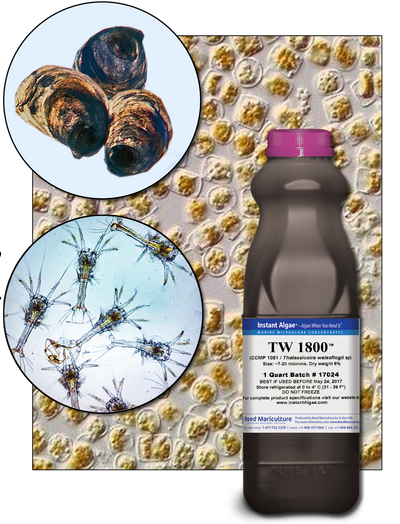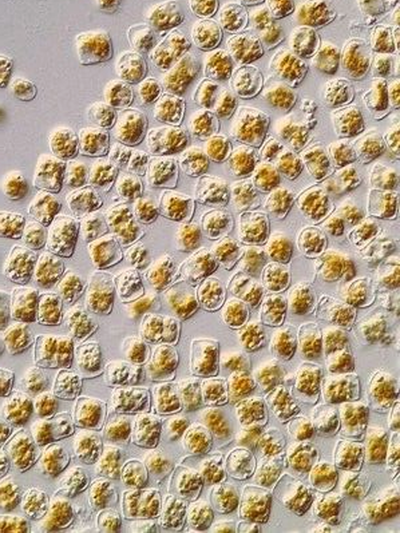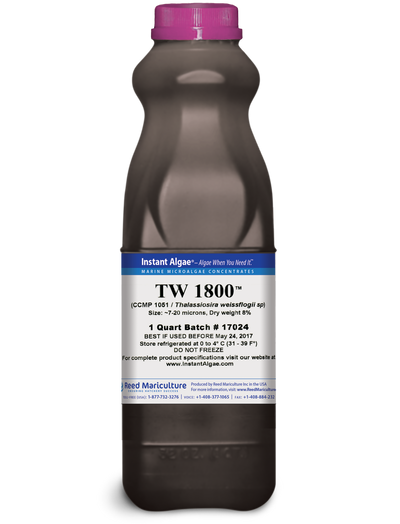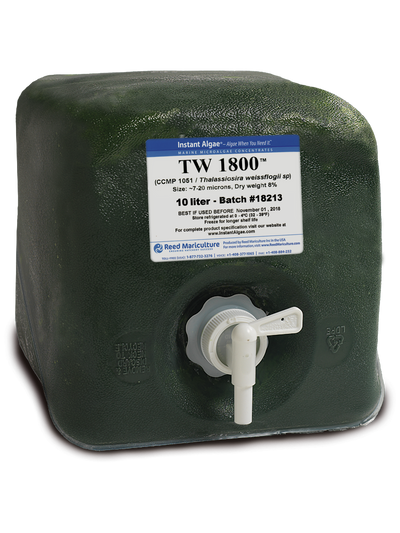



TW 1800
Thalassiosira weissflogii is a large Diatom (6-20µm x 8-15µm) that is used in the shrimp and shellfish larviculture industry. This algae is considered by several hatcheries to be the single best algae for larval shrimp.
Product Description
Applications & Benefits
APPLICATIONS
Effective for larvae after day 7, setting, spat and broodstock conditioning; produces
increased growth and survival rates. Common applications:
- Peak Load Supplement 100%
- live algae replacement
- Remote set
- Back-up feed supply
- For use with open tanks, silos, bottle upwellers, header tanks, cultch tanks and depuration tanks
- Effective for many species including artemia, crab, sea cucumber and some copepods
BENEFITS
- Biosecure
- Exceptionally Clean
- Easy to use
- Always available
- Balanced lipids, protein, and carotenoids
- Effective feed supplement and live algae replacement
Directions & Feeding
Directions
- When water is circulated with a centrifugal pump, such as with an upweller, add in front of the pump intake and the pump will disperse the algae cells.
- When feeding into open tanks or header tanks, pre-dilute the algae 10:1 with system water
a. Add system water to a small bucket.
b. Add TW 1800 and stir.
c. DO NOT BLEND; it is unnecessary and may damage the algae cells.
d. Pour into larvae or spat tank.
e. Pouring through a 20–micron screen can improve dispersion. - Feed according to the table below. Adjust dosage to meet the needs of your hatchery and larvae.
- Refrigerate bottle when not in use. Use within 8 days of defrosting
Typical Feeding Ration
Larvae
Feed according to shell length. Shell length on a given day is an estimate. Larviculture may run up to 20 days.
Daily Feed Rates per million larvae, Crassostrea virginica
(from FAO Protocol ‘Hatchery culture of bivalves 2004’)
| Shell Length | Day | Shellfish Diet (ml) | = | Live Isochrysis(L) @4x106 |
|---|---|---|---|---|
| 75 | 2 | N/A | = | N/A |
| 95 | 3 | N/A | = | N/A |
| 100 | 4 | N/A | = | N/A |
| 115 | 5 | N/A | = | N/A |
| 130 | 6 | N/A | = | N/A |
| 145 | 7 | 4.5 | = | 5.1 |
| 160 | 8 | 5.7 | = | 6.6 |
| 190 | 9 | 8.2 | = | 9.5 |
| 220 | 10 | 10.8 | = | 12.4 |
| 240 | 11 | 12.5 | = | 14.4 |
| 260 | 12 | 14.2 | = | 16.3 |
| 270 | 13 | 15.1 | = | 17.3 |
| 280 | 14 | 15.9 | = | 18.3 |
Spat
Feed by Live Weight
• 0.9ml TW 1800 per gram live weight of spat per day
Broodstock Conditioning and Fattening
Typical Broodstock Feed Rates
- 0.04–0.08 ml TW 1800 per gram wet meat weight per day*
OR:
- 0.4–1.5 ml TW 1800 per adult animal per day (depending on feed ration and size*)
- Provides between 2% and 4% dry weight feed for dryweight of meat
Storage & Technical Data
| Packaging | 1 liter bottle, 10-liter Cubitainer® |
|---|---|
| Storage | Refrigerated: 4 months; Can be frozen for longer shelf life. |
| Tip | Keep frozen before defrosting, refrigerate after defrosting |
| Physical Properties | |
|---|---|
| Appearance | Viscous brown concentrate |
| Algal cell size | 10 - 15 microns |
| Cell Density | ~0.64 Billion cells per ml |
| Algal Biomass | 120g Dry biomass/L |
| Composition of Dry Algal Biomass | |
|---|---|
| Protein | 454 % |
| Lipid | 10 % |
| DHA | 9.3 % (% of lipids) |
| EPA | 20.5 % (% of lipids) |
| Carbohydrate | 12.0 % |
| Ash | 33.0 % |
| Composition of Liquid Product | |
|---|---|
| Protein | > 9.8 % |
| Lipids | > 2.5 % |
| Carbohydrate | > 3.2% |
| Ash | < 10 % |
| Moisture | < 87 % |
| Microbial Specification | |
|---|---|
| Coliform Bacteria | < 0.3 mpn/mL |
| Salmonella | Negative |
| Known pathogenic marine bacteria | Negative |

